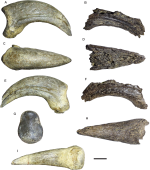albertonykus
Well-known member
Acosta Hospitaleche, C. and W. Jones (2024)
Were terror birds the apex continental predators of Antarctica? New findings in the early Eocene of Seymour Island
Palaeontologia Electronica 27: 13
doi: 10.26879/1340
Two ungual phalanges attributed to large birds were collected in the Ypresian (early Eocene) levels of the Cucullaea Allomember (Submeseta Formation). Both materials were found in localities in proximity on Seymour Island in West Antarctica. The pronounced curvature, considerable size robustness, and the extension of the flexor tubercle provide compelling evidence for their classification within Cariamiformes. Additionally, the results of quantitative analyses strongly support this assignment to Phorusrhacidae or a Phorusrhacidae-like bird resembling Phorusrhacos longissimus. These phalanges belonged to a large or even giant predator, estimated to have had a substantial body mass of around 100 kg. It is highly likely that this bird was an active predator, hunting and feeding on small marsupials and medium-sized ungulates. This finding fundamentally changes our understanding of the dynamic within the Antarctic continental ecosystems during the early Eocene. It reveals that large carnivorous birds assumed the role of continental apex predators apparently sub-occupied by mammals.
Were terror birds the apex continental predators of Antarctica? New findings in the early Eocene of Seymour Island
Palaeontologia Electronica 27: 13
doi: 10.26879/1340
Two ungual phalanges attributed to large birds were collected in the Ypresian (early Eocene) levels of the Cucullaea Allomember (Submeseta Formation). Both materials were found in localities in proximity on Seymour Island in West Antarctica. The pronounced curvature, considerable size robustness, and the extension of the flexor tubercle provide compelling evidence for their classification within Cariamiformes. Additionally, the results of quantitative analyses strongly support this assignment to Phorusrhacidae or a Phorusrhacidae-like bird resembling Phorusrhacos longissimus. These phalanges belonged to a large or even giant predator, estimated to have had a substantial body mass of around 100 kg. It is highly likely that this bird was an active predator, hunting and feeding on small marsupials and medium-sized ungulates. This finding fundamentally changes our understanding of the dynamic within the Antarctic continental ecosystems during the early Eocene. It reveals that large carnivorous birds assumed the role of continental apex predators apparently sub-occupied by mammals.





